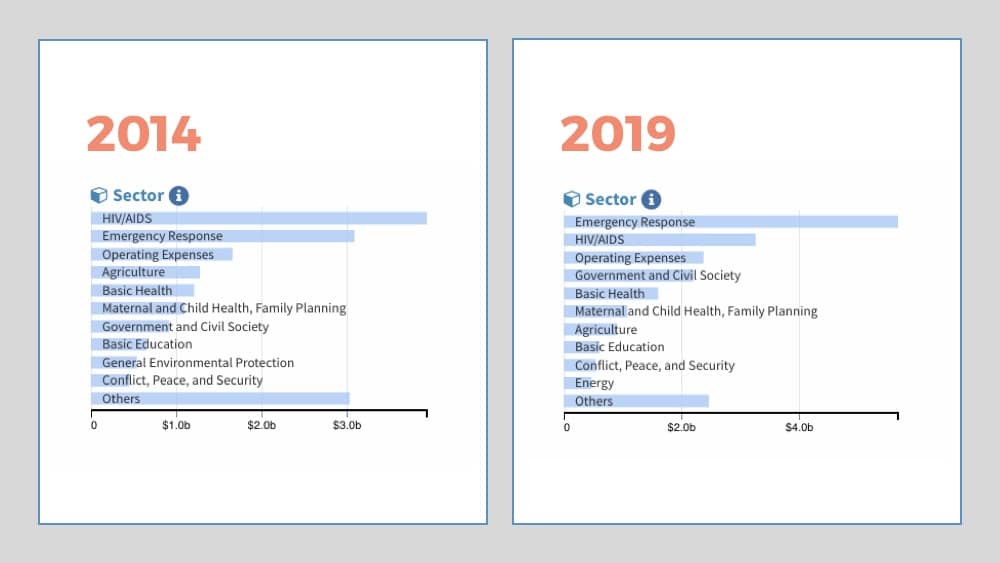What does a Biden win mean for USAID?
As a fundraiser, I get asked the same question every four years: “What does this candidate mean for foreign aid?”. Having been working in development for quite a few elections, I find it difficult to answer this question in a way. Historically speaking, the quick answer is that in terms of funding, Democratic Presidents (and Congress) allocate a bit more funding to foreign aid than Republicans. One exception to this was the President’s Emergency Plan For AIDS Relief (PEPFAR) which was initiated by Bush in 2003 and provided $80 billion in cumulative funding for HIV/AIDS treatment, prevention, and research.
To put it in perspective, foreign aid (specifically USAID) has been around +/-2% of the entire federal budget for the past 10 years. Last year, USAID’s budget was USD 20,6 billion and five years ago, it was at USD 18 billion. Next year’s fiscal budget request is slightly lower than last year’s at around USD 19, 6 billion.

What influences foreign aid allocation?
Well, both public opinion and the economy have historically swayed things one way or another. Over the past few years, there has been a general trend amongst Americans — both Democrat and Republican — to move towards isolationism and a reduction in foreign aid spending. One could argue that the rhetoric of Trump influenced this opinion. What is more influential, however, is the lack of knowledge about how much of the federal budget is allocated for foreign aid. In a poll conducted by World Public Opinion, most people estimated that foreign aid spending was around 25 percent. This misbelief, coupled with a likely economic recession, could negatively impact the FY2022 budget.
While the overall USAID budget may not fluctuate more than 10% over any given time, what does indeed change is policy priorities and program area spending.
While the overall USAID budget may not fluctuate more than 10% over any given time, what does indeed change is policy priorities and program area spending. For example, in 2014, the majority of funding was allocated to HIV/AIDS. Last year, most likely because of COVID and other natural disasters, more money was allocated to Emergency Response.


Which changes can be expected?
The biggest change, however, that one could expect from one Administration to another Administration is that the rhetoric of the Administration impacts the programmatic decisions within the Agency. When more conservative candidates have entered the Presidential office and/or when the Congress has been dominated by conservatives, the agency would experience programmatic impact such as stringent geographic procurement restrictions, the prohibition of post abortion care in maternal health programs, ABC (Abstinence, Be faithful, and as a last resort use Condoms) within HIV/AIDS programs, fewer inclusive rights programs, and less funding towards the environment. One of the more drastic consequences of the Trump presidency has been the reduction (and sometimes total cutting) of scientific research and development programs. For example, one program that cut was a USAID program called Predict. This was an initiative aimed at identifying and preventing animal viruses that might someday infect humans. #badtiming
It is realistic to think that [Biden’s] approach will include reanimating relationships with multilateral institutions and other countries.
Knowing Biden’s historical support for foreign engagement and international collaboration, it is realistic to think that his approach will include reanimating relationships with multilateral institutions and other countries. And while there is some discussion that he may undertake major reforms which would include a restructuring of USAID, I believe that the domestic and economic climate would not allow for that kind of focus on foreign aid. In other words, foreign aid would take a back burner position when compared to the more pressing domestic issues of polarization.
The real wild card in all of this is that Trump still has not conceded the election (at the time of writing this post). This will have a major side-effects over what USAID can do in the next few months. So far, GSA Administrator Emily Murphey has not signed the letter to help transition USAID to the next political appointee. This letter is crucial as it releases millions of dollars and provides access to government officials, office space, and equipment. Furthermore, John Barsa, who is the acting Deputy Administrator, has declared that the agency will not cooperate with the transition until Murphy does so. In other conversations, Barsa has told colleagues that Biden has not won and emphasized the importance of not abetting the process*. So, to make a long answer short — the next couple of months will be a rocky road for USAID and we will certainly see an impact on both the employees and their program beneficiaries.
* Source: Washington Post, Top Trump appointee at USAID tells colleagues not to support Biden transition, Nov 9, 2020

Juliet MacDowell
Marketing Director at SCOPEinsight
stay up to date
We have at heart to be a resource to you. According to your preference, we will share insights, trainings, networking events and career opportunities that might be of interest for anyone from entry-level to seasoned professionals.
Contact
Phone
+31 (0)6 30 69 45 95
Address
Eursinge 8, 7935AB Eursinge (de Wolden), The Netherlands
228 East 45th Street, Suite 9E New York, NY 10017, USA
info@hvfc-international.com
Join us on
© 2024 HVFC International. All rights reserved.
HVFC ® is a registered trademark of HVFC International B.V.

